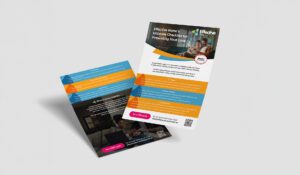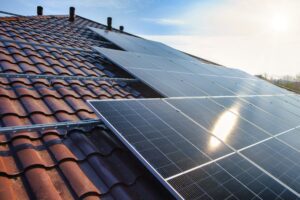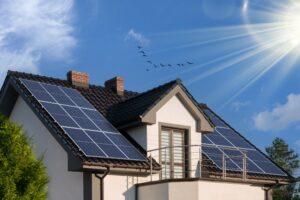Rooftop solar panels give us free electricity from renewable energy, but the amount of power they produce varies according to the angle they’re installed at. So, what is the best angle for solar panels in the UK? Is the direction the roof faces important? This post answers these questions.
You’ll also find out what else affects solar output, and whether solar panels can be installed on both sides of a roof, on a flat roof, or at ground level.
Why Solar Panel Angle Matters
Solar panels absorb sunlight and generate electric current from it. The angle of the solar array affects how effectively they do this. Most solar panel systems are installed on the roof so they get maximum sunlight. The angle of installation is an important consideration, and installers need to work with the slope of the roof.
Solar panels are usually installed flush with the roof, so its slope determines their angle from the horizontal. The best angle – vertical tilt of the panels – allows the panels to capture the most sunlight.
More than 93 percent of homes in the UK have a sloping (pitched) roof, which provides protection from the elements and facilitates rainwater runoff. The standard range of roof angles is from 30 to 50 degrees, which is good for solar panels.
- Create a Tailored Quote Based On Your Circumstances
- Takes Less Than 2 Minutes
- Fixed-Online Quotes

Best Solar Panel Angles By Regional Location
Solar energy systems in general work reasonably well at angles anywhere from around 20 to 50 degrees. Optimal performance is typically achieved somewhere in the middle of this range.
The best angles for solar panels in different areas of the UK are as follows.
- South east – 35.9°.
- South west – 35.8°.
- North – 37.2°.
- Scotland – 37.8°.
- Wales – 36.3°.
- Northern Ireland – 37.2°.
These figures differ slightly because levels of sunlight in the UK vary by geographic location – from day to day, season to season, and year to year.
In general, solar panels on homes in the south and east produce most electricity because they get more sun than those in the north or west. However, the UK gets more than enough sunlight to power solar panels in all parts of the country. This is because although solar energy systems work best in direct sunlight, they also produce electricity from indirect light when it’s overcast.
Solar Panels And Roof Orientation
Besides solar panel angle, the direction your roof faces is also important for power generation. Residential roofs usually face two opposite directions. Ideally, for solar power, one of these should be south. In the UK – in the northern hemisphere – solar panels work best on a south-facing roof because it gets the most sun.
The best solar panel angle to maximise power output is around 35 degrees on a south-facing roof. But you can still enjoy the advantages of solar power without a south-facing roof, although you may need more panels.
The next-best options are panels that face east or west. Panels on these roofs produce around 15 to 20 per cent less electricity. North-facing panels are the least effective because they get around half as much sun as panels facing south.
Light Energy Capture Of Solar Panels At 30° To 50° Degrees
- Panels facing south – 97 to 100 percent of available sunlight.
- Panels facing east – 80 to 86 percent.
- Panels facing west – 78 to 86 percent.
- Panels facing north – 55 percent.
Other Factors That Affect Solar Output
Solar panel efficiency isn’t all about angle and direction. Other considerations range from the solar panels themselves and how well they’re maintained to the time of the year and shading issues.
Your Solar Panels
The amount of electricity your solar panels produce depends on how efficient they are – how effectively they turn daylight into electricity.
The higher the efficiency, the greater the power output. Efficiency levels of residential solar panels typically range from around 15 to 24 percent. Panels with monocrystalline solar cells are the most efficient.
- Create a Tailored Quote Based On Your Circumstances
- Takes Less Than 2 Minutes
- Fixed-Online Quotes

Solar Panel Maintenance
Most solar panels are designed to be self-cleaning. They have a protective coating that results in rainwater washing away dust and dirt and debris such as fallen leaves and bird droppings.
But in some cases this isn’t enough and manual cleaning may be necessary once or twice a year.
Time Of Year
Solar panels generate different amounts of electricity throughout the year as the seasons change. They produce about 70 percent of their total output in spring and summer.
Solar output is most productive in summer, with longer hours of daylight and the sun higher in the sky. Power generation dips in winter, when the sun is lower in the sky and the days are shorter.
Shade
Power generation can be reduced significantly if shade stops sunlight reaching solar panels. Besides cloud cover, they can also get less light because of surrounding trees, satellite dishes, buildings and chimneys.
Some of these issues can be resolved by measures such as pruning trees and relocating dish aerials.
Can Solar Panel Angle Be Adjusted?
Ideally, solar panel angle would vary with the seasons as the sun’s position changes. For instance, the best angle in summer is on average 20 degrees and in winter 50 degrees.
This means the angle of the solar panels would have to be adjusted at least twice a year – in summer and winter, when the sun is highest and lowest in the sky, respectively.
This would entail extra expense and isn’t typically practical for homeowners. Another way of adjusting solar panel angle is with a solar tracking system.
Solar Trackers
Solar trackers adjust solar panel angles so they follow the movement of the sun. Solar tracking is usually incorporated into ground-mounted solar panel systems. (More on these later).
But trackers can also be used with rooftop solar panels. However, the cost is likely to be prohibitive for most households and are rarely used in residential applications.
Can Solar Panels Be Installed On Both Sides Of A Roof?
Solar panels can be placed on both sides of a roof provided they get sufficient sunlight. In fact, there’s a growing trend of installing solar panels on the front and back of a roof that doesn’t have a south-facing aspect.
Panels on both sides of a roof with an east-west axis maximise power output by capturing more sunlight – from early morning to late afternoon in summer. This saves more money on energy bills by further reducing reliance on mains electricity from the National Grid.
East-facing solar panels will get sunlight during the morning, and the west-facing panels take advantage of the sunlight available later in the day. On the downside, the increased number of panels raises the cost and installation is more complex. More panel maintenance will also be necessary.
For properties with multiple roof sections, panels can be installed on the south, east and west elevations.
Can You Put Solar Panels On A Flat Roof?
Solar panels on a flat roof are not only possible but can be as effective as on a pitched roof, despite the lack of a significant slope. (Flat roofs are angled slightly to allow water runoff).
Depending on factors such as accessibility and available space, installation of solar panels on a flat roof is often simpler, which lowers the cost.
Additional considerations are necessary, though, to make sure the system operates at its best. These include angling the panels so they get maximum sunlight. Installers do this with specially designed tilted frames.
And a gap of about one metre needs to be left between each row of panels. This avoids shade from the raised structure of one section falling onto other panels. But it may limit the number of panels that can be installed, compared with a pitched roof, where the panels are closer together.
Solar panels in general require little maintenance and a flat roof makes the job even easier and safer, particularly with the space between the rows. A solar panel system on a flat roof is also more discreet aesthetically. The panels are unlikely to be visible from the ground, too.
Can You Install Solar Panels At Ground Level?
The angle of some roofs may not be ideal for solar panels, or lack of space could be a problem. In these cases, ground-mounted solar panels are an option provided you have enough space on your property. A ground-mounted solar panel system for the average three-bedroom home will take up 20 to 35 square metres of land.
A solar array installed a few inches or higher off the ground is up to 25 percent more efficient than rooftop solar panels. And they’re easier to maintain – no one has to climb onto a roof.
Sun-tracking systems in ground-level solar arrays allow control over the angle of the panels and the direction they face, so you can optimise power output. Installation costs are generally higher because of site preparation, the need for a supporting structure, and running electrical cables under the ground, however.
Installing ground-mounted solar panels typically requires planning permission, which isn’t usually necessary with rooftop panels.
Ready To Go Solar?
Solar panels work efficiently on most roofs in the UK. They reach maximum power output when they’re angled at 35 degrees and facing south. But they’ll still cut energy bills if your roof faces a different direction and slopes less or more.
Leading UK renewable energy specialist Effective Home fully understands the best angle for solar panels and how to position them facing the optimal direction.
We install solar panel systems so they get as much sun exposure as possible and generate the maximum amount of electricity, taking into account the slope and orientation of your roof.
If you’re looking to have solar panels on a flat roof or at ground level, that’s no problem either. Contact us now for a free quote.
- Create a Tailored Quote Based On Your Circumstances
- Takes Less Than 2 Minutes
- Fixed-Online Quotes




